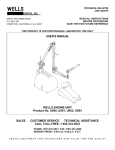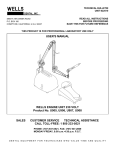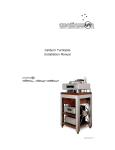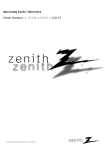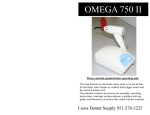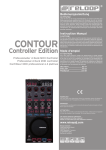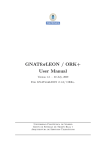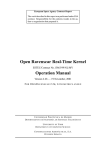Download Motion Sound KBR-3D Specifications
Transcript
1 KBR-3D -WARNINGThe KBR-3D can produce extremely high sound pressure levels. Hearing protection is advised. The KBR-3D must be earthed and connected to a correct power source. -SPECIFICATIONS- Design Range: Rotary Channel Stereo Channel Power amp inputs Dry rotary output Input 1 Input 2 All inputs 375 mV RMS Unlimited 175 mV RMS 420 mV RMS 420 mV RMS 100K ohms 50K ohms 100K ohms 22K ohms 600 ohms Tube: 12AX7EH – 7025 – 5751 Power Amplifiers: 100/100 watt RMS main full range amplifiers 45-watt RMS > 800 Hz horn amplifier Frequency Response: Full Range speakers 50-15 kHz + -5 dB Horn driver 600 Hz-8 kHz Speakers: 2 10” Eminence Beta 250-watt, 8 ohms 2 80-watt 3.5X3.5 Ferro-cooled horns, 8 ohms 1 80-watt MS 1.2 proprietary diaphragm horn driver, 8 ohms Dimensions: 24” W 21” H 16” Weight 68 lbs. Power: US Europe Japan 117 VAC 230 VAC 100 VAC 50/60 Hz 50/60 50/60 300 watt 300 watt 300 watt Fuse (Slo-Blow) 5 amp 2.5 amp 5 amp Fuse Location: The fuse is located in the power inlet module on the rear panel. Use only the recommended size of fuse as stated above. 2 -DESCRIPTIONThe Motion Sound KBR-3D is a state-of-the-art amplifier for keyboard providing all of the features necessary to reproduce stereo and rotary sound independently. The two channels employ technology that is specifically targeted to reproduce and enhance the sound of instruments normally associated with each channel. Hi-Fidelity stereo = piano, strings and synthesizer. Rotary = organ. If your keyboard has multiple outputs, you can send stereo piano and strings, etc., to the stereo channel from the standard left and right outputs of your keyboard. Organ sounds (be sure to turn off the rotary simulator in your keyboard) may be assigned to an auxiliary output and plugged into the KBR-3D’s rotary channel. Left/right line level inputs on the rear panel allowing mixing boards for microphone and other instruments to be fed directly to the KBR-3D’s power amplifiers. The rear panel has left and right XLR outputs and a mixer for the rotary channel stereo horn microphones. There are two 10” 250-watt Eminence Beta speakers and two 3.5X3.5” 80-watt Ferro cooled horns driven by 100/100-watt amplifiers provide stunning clarity and transient response. A 12AX7EH tube pre-amp and 45-watt amplifier driving a 80watt MS-1.2 diaphragm for the rotary horn in conjunction with the enhanced stereo low rotor simulator provide rich liquid REAL rotary sound. -QUICK START1. Set all controls to the default number indicated on each control. 2. Set keyboard to 50% volume; plug into the KBR-3D’s appropriate channel. 3. Fine tune volume and tone controls to suite your taste. -ROTARY CHANNELThe KBR-3D employs Motion Sound’s acclaimed PRO-3T rotating horn technology, including a 12AX7EH pre-amp circuit and the MS 1.2 proprietary diaphragm. The low rotor simulator is specifically designed for the KBR-3D’s speaker cabinet and provides rich, liquid stereo simulation. Inputs: 1. Input “1” is designed for use with a single keyboard or organ module. 2. Input “2” when used alone (without input 1) attenuates the incoming signal by 50%. This input impedance is reduced to 33K ohms. 3. Analog volume pedals are not recommended. 3 Speed Control: Connect the supplied dual button foot switch here. This is a TRS connector where the sleeve is common or ground, the “tip” controls fast/slow operation and the “ring” determines whether slow or stop is enabled. Fast overrides all: When the fast speed is on (yellow fast indicator on the KBR-3D is lit), the stop button does not have effect. When the fast button is pressed again (yellow indicator off) the slow speed or stop is enabled depending on the position of the stop switch button. This enables the horn motor and low rotor simulator to cycle between fast to slow, fast to stop and slow to stop. The rotors will follow the acceleration times as set internally. Disable Stop: If the stop function is not desired, a single contact switch can be used with a mono ¼’ jack. The stop is disabled by the sleeve of the ¼” connector and the switch button then controls fast/slow only. Pre-Gain: Inputs 1 and 2 are fed to this control before reaching the 12AX7EH tube circuit. The pre-gain is actually an attenuator allowing input levels to be virtually unlimited. Contour: This knob controls the high frequency response of the rotary channel. The 147 position (approx. 5 kHz role off) is similar to many older rotating speakers. If you would like a brighter sound, choose the PRO-3 (approx. 7 kHz roll off) setting. The control also provides positions in between to allow for today’s keyboards and personal taste in high frequency response. 12AX7EH Pre-Amp: There are no solid state devices in this unique tube circuit which utilizes a 12AX7EH (or any of its derivatives) in a self-biased symmetrical clipping topology that behaves like a 147 tube output stage when overdriven. This design provides silky-smooth sound until pushed into clipping, at first crunchy and at extremes provides a gnarly massive tube grind! A combination of keyboard volume X volume pedal X pre-gain settings determines the overall drive of the 12AX7EH. Post-Gain: This control allows silky-smooth, clean tube sound with settings of 8-10 and utilizes the full output range of the 45-watt RMS horn power amplifier. When turned down and used in conjunction with the pre-gain and keyboard volume controls, the post-gain allows all levels of overdrive to be played at any volume below the 45-watt amplifier’s clipping point and can provide tube only overdrive at loud to very soft levels. Many users like to set a level or “ceiling” with the pre-gain around 5 and about 50% volume on their keyboard, a point where the 12AX7EH runs fairly clean and then be able to push the tube into clipping by conveniently raising the volume on the keyboard. Again, overall volume can be changed with the post-gain without affecting this “ceiling” level. Clean Sound Crunch Gnarl pre-gain 1-5 5-8 8-10 post-gain 8-9 3-7 1-7 Settings depend on a signal source level of approximately 300 mV RMS fed into the KBR-3D rotary channel input 1 only (input 2 not used). Low Rotor Volume: The balance between sound from the rotating horn (> 800 Hz) and that of the low simulator is adjusted here. Set the balance to default or to match your favorite classic rotating speaker or personal taste. Bass: The control effects bass frequencies below approx. 150 Hz. Generally set to “0”, this is also a personal taste control. If you play with a bas player, leave the control between –10 to 0. If you play solo and use pedals, try a settings of 0- +5. Bass reproduction uses a great deal of power— use only what seems needed in each situation. 4 Low Rotor Effect: This controls the amount of low rotor simulator effect. The circuit design is unique to the speaker placement and angle of the KBR-3D’s cabinet. Typical settings of 7-9 are best. This is also a personal preference control. Overall Rotary Tone: This is a combination of contour, low rotor level and bass settings. If overdrive distortion is part of your sound, set that first with the pre-gain and post-gain controls and then set the low rotor volume, contour and bass. The personal preference settings of these controls provide a wide range of overall sound, covering many styles of music past and present. -STEREO CHANNELThe KBR-3D’s stereo section employs high fidelity design throughout, from the low noise preamp to the 100/100 watt power amplifiers. The unique angled front allows maximum effect from the stereo field expander. The expander, speaker arrangement and cabinet angle will enhance and spread a stereo signal source into a field much wider than the cabinet itself. The expander relies on a stereo sound source and the effect will vary according to the quality of the source. Input 1: When a stereo input is applied to the left and right channels, the stereo expander is functional. If a signal is applied to the right/mono input only, it is routed to both left and right tone controls and power amplifiers. Input 1 left and right inputs can also be used as independent amplifiers although the volume and tone controls are global. Input 2: When a left and right stereo signal is applied, it is routed to the tone controls (global) and to the power amplifiers. The right/mono input will send a mono source to the tone controls and both amplifiers. Input 1 and 2 can also operate as independent amplifiers with global tone and volume controls. Expand: This circuit operates on input 1 only. The expand switch and corresponding yellow indicator selectively enhance the difference between the left and right sounds of a stereo signal. The better the signal source, the more profound the apparent expansion of the sound field. With some signal sources, tone will change when the expander is turned to extremes. A small tone control adjustment may be desirable. It is best to use the lowest effective expander setting. The on/off expand switch allows fast A-B comparison of the effect. Do not use the expander if input 1 is used with a mono source or as two separate amplifiers with separate instruments. No harm will be done but the effect will be unpredictable. Bass: The bass control operates from 150 Hz down. Bass generally uses a lot of power and should be adjusted carefully to match the playing venue and instrument complement. If you have a bass player, try settings of 0-5. This is a personal preference control. Middle: This control operates from 150 Hz to 3 kHz and adjusts the fundamental sound of most keyboard instruments. Levels of 3-7 are common. This is a personal preference control. Treble: This controls frequencies from 3 kHz to 20 kHz. The high-sizzle and clarity are set here. Treble can be very piercing and because of the “spongy” nature of air is quickly absorbed. Don’t fry your ears on stage with treble-heavy sound that may never reach the audience. A typical setting would be 4-8. 5 Overall Stereo Settings: The KBR-3D stereo channel utilizes total attenuation tone controls, thus if bass, middle and treble are set to “0”, virtually no sound will get through to the power amp section! This is very versatile but at least one of the tone controls should be set to “3”. Best signal to noise Loudest operation Bass 2-6 6-9 Middle 2-6 6-9 Treble 2-6 6-9 Use lower numbers in quiet settings; use higher numbers at loud venues. -REAR PANEL CONNECTIONSXLR Line Outputs: Signals from the low rotor simulator, the line level inputs, and the full range stereo channel is sent here. The horn level, as set by the microphone mixer, is also present (Z out approximately 600 ohms; 70 mV RMS nominal). Microphone Volume: These two controls mix the rotary channel horn microphones >600 Hz into the XLR outputs. The level should be set after all parameters on the rotary channel preamp are adjusted. The microphone mixer can be set to zero if external miking is preferred. ¼” Line Level Inputs: These inputs feed directly to the 100/100 amplifiers and are not affected by either pre-amp setting. You can connect a mixing board for vocals or any other typical signal source (420 mV RMS nominal). Volume must be controlled by the signal source. Dry Rotary Output: This signal is tapped just after the 12AX7EH post-gain control, before the low rotor simulator volume and bass controls. It provides a line level output to drive reverbs and other effects where the rotary effect is not desirable. Many “classic” organ speakers used “non-rotary” reverb in conjunction with rotary sound (420 mV RMS nominal). Power Supply: The KBR-3D contains two 100 watt power amplifiers for the full range system and 45-watt amplifier to drive the horn from>800 Hz. The power supply is capable of 200 watts RMS that is shared between the three amplifiers. Music is almost always transient in nature and tests have verified the cost/weight effectiveness of this supply in the KBR-3D. Volume levels requiring sustained 200 watt performance should be assisted by a PA system, both for hearing protection and for a generally better sound. Speakers: The KBR-3D utilizes high efficiency 10” 250-watt speakers and 3.5X3.5” Ferro cooled horns. Reproduction of piano was of primary concern during speaker selection. The transient nature of piano is one of the best indicators of an amplifier’s performance. The KBR-3D cabinet angle and speakers provide an incredible 120 degrees of treble dispersion producing a wide angle of full frequency response. 6 Rotary Horn: The horn driver of the rotary channel utilizes a proprietary 80-watt diaphragm specifically designed to reproduce organ sounds from modern and classical keyboards. These instruments rarely needed response above 8 kHz. The driver provides rich, “musical” response over this most desirable range. (You must use a Motion Sound MS 1.2 proprietary diaphragm.) -INTERNAL ADJUSTMENTS AND MAINTENANCECabinet Finish The new Polymaric (proprietary polymer) finish is similar to a “truck bed-liner” coating. Wiping the finish with a damp cloth should be all that is needed. Speaker Replacement/Removal Remove the screws holding the respective grill cover on to gain access to the speakers and horns. The 10“ speaker is removed from the front and must be removed first to allow access to the rear mounted horn. The horn crossover is mounted on the rear of the horn and must be included with a replacement. Carefully remove the four mounting screws and remove the speaker from the front. Disconnect the two crossover wires (note polarity) to allow removal from cabinet. Amplifier, Tube, Belt, Diaphragm Removal/Access 1. Remove the 4 screws on each grill cover and remove both grill covers. 2. Carefully remove the two 10” speakers and disconnect the spade lugs (note connection polarity when removing the wires), then remove the two tweeters. 3. Remove the 3 screws on the round black plastic axle support on the top center of the cabinet and lift up and out the support. This is the last part to be replaced on re-assembly. 4. Inside each speaker cabinet there are phillip screws that go up into the metal chassis, remove them. (7 in the left and 5 in the right side). 5. Remove 6 phillip screws on the back of the chassis. 6. Slide the chassis out the rear, be careful to feed the speaker wires through as the chassis moves out. For Horn Diaphragm Removal 7. The diaphragm is located through the bottom access hole of the chassis. Remove the 2 spade lugs. 8. Remove the diaphragm, it may be a tight fit so a little force is okay. (note orientation) 9. Diaphragm Replacement Instructions will be sent when you order your MS 1.2 from Motion Sound. Tube 7 Motion Sound currently uses an Electroharmonix 12AX7EH tube. Motion Sound recommends replacement with a 12AX7EH, 5751, or 7025. If this is not possible, a 12AX7 can be used if the gain is adequate. Belt The medical grade “pyrathane” anti-static belt is custom manufactured for Motion Sound and will provide years of service. DO NOT USE other belts, as they will damage the servo motor drive system. Belts are available from Motion Sound. Horn Diaphragm Motion Sound used a proprietary MS-1.2 diaphragm. DO NOT USE other diaphragms. You can purchase the MS-1.2 through Motion Sound. -Internal User Adjustments- The dynamics and speeds of the KBR-3D’s horn motor and low rotor simulator are calibrated at the factory to simulate a 147 type rotary speaker that is well used but maintained. Three parameters of the horn and low rotor simulator may be adjusted to user preference as follows (note original position of potentiometers before turning). The controls for the horn and simulator are labeled: S = Slow speed F – Fast speed A = Acceleration The adjustments are labeled on the PC board. To access the adjustments see amplifier removal information. 8 9









